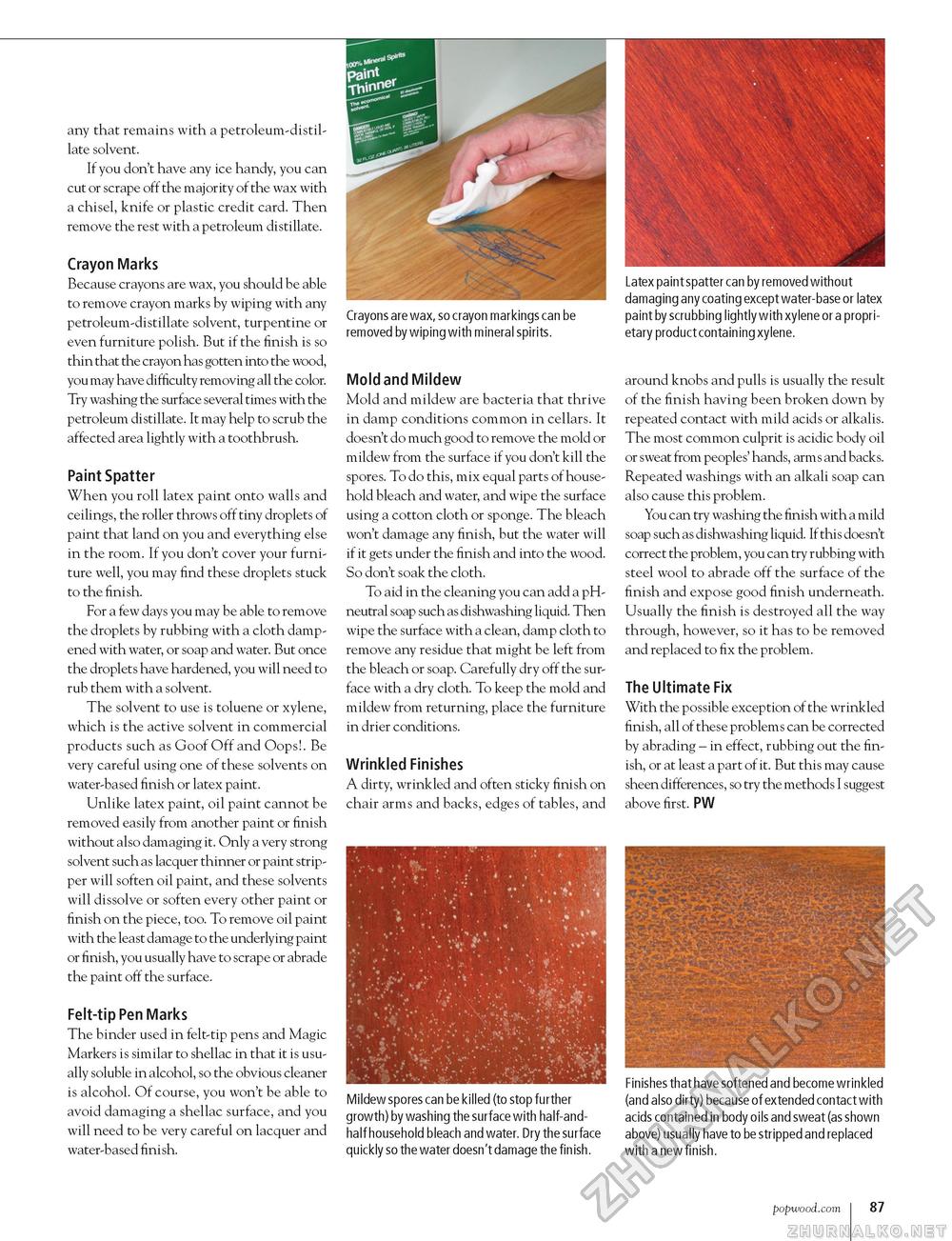Popular Woodworking 2005-08 № 149, страница 89
any that remains with a petroleum-distillate solvent. If you don't have any ice handy, you can cut or scrape off the majority of the wax with a chisel, knife or plastic credit card. Then remove the rest with a petroleum distillate. Crayon Marks Because crayons are wax, you should be able to remove crayon marks by wiping with any petroleum-distillate solvent, turpentine or even furniture polish. But if the finish is so thin that the crayon has gotten into the wood, you may have difficulty removing all the color. Try washing the surface several times with the petroleum distillate. It may help to scrub the affected area lightly with a toothbrush. Paint Spatter When you roll latex paint onto walls and ceilings, the roller throws off tiny droplets of paint that land on you and everything else in the room. If you don't cover your furniture well, you may find these droplets stuck to the finish. For a few days you may be able to remove the droplets by rubbing with a cloth dampened with water, or soap and water. But once the droplets have hardened, you will need to rub them with a solvent. The solvent to use is toluene or xylene, which is the active solvent in commercial products such as Goof Off and Oops!. Be very careful using one of these solvents on water-based finish or latex paint. Unlike latex paint, oil paint cannot be removed easily from another paint or finish without also damaging it. Only a very strong solvent such as lacquer thinner or paint stripper will soften oil paint, and these solvents will dissolve or soften every other paint or finish on the piece, too. To remove oil paint with the least damage to the underlying paint or finish, you usually have to scrape or abrade the paint off the surface. Felt-tip Pen Marks The binder used in felt-tip pens and Magic Markers is similar to shellac in that it is usually soluble in alcohol, so the obvious cleaner is alcohol. Of course, you won't be able to avoid damaging a shellac surface, and you will need to be very careful on lacquer and water-based finish. Crayons are wax, so crayon markings can be removed by wiping with mineral spirits. Latex paint spatter can by removed without damaging any coating except water-base or latex paint by scrubbing lightly with xylene or a proprietary product containing xylene. Mold and Mildew Mold and mildew are bacteria that thrive in damp conditions common in cellars. It doesn't do much good to remove the mold or mildew from the surface if you don't kill the spores. To do this, mix equal parts of household bleach and water, and wipe the surface using a cotton cloth or sponge. The bleach won't damage any finish, but the water will if it gets under the finish and into the wood. So don't soak the cloth. To aid in the cleaning you can add a pH-neutral soap such as dishwashing liquid. Then wipe the surface with a clean, damp cloth to remove any residue that might be left from the bleach or soap. Carefully dry off the surface with a dry cloth. To keep the mold and mildew from returning, place the furniture in drier conditions. Wrinkled Finishes A dirty, wrinkled and often sticky finish on chair arms and backs, edges of tables, and around knobs and pulls is usually the result of the finish having been broken down by repeated contact with mild acids or alkalis. The most common culprit is acidic body oil or sweat from peoples' hands, arms and backs. Repeated washings with an alkali soap can also cause this problem. You can try washing the finish with a mild soap such as dishwashing liquid. If this doesn't correct the problem, you can try rubbing with steel wool to abrade off the surface of the finish and expose good finish underneath. Usually the finish is destroyed all the way through, however, so it has to be removed and replaced to fix the problem. The Ultimate Fix With the possible exception of the wrinkled finish, all of these problems can be corrected by abrading - in effect, rubbing out the finish, or at least a part of it. But this may cause sheen differences, so try the methods I suggest above first. PW Mildew spores can be killed (to stop further growth) by washing the surface with half-and-half household bleach and water. Dry the surface quickly so the water doesn't damage the finish. Finishes that have softened and become wrinkled (and also dirty) because of extended contact with acids contained in body oils and sweat (as shown above) usually have to be stripped and replaced with a new finish. popwood.com I 87 |








